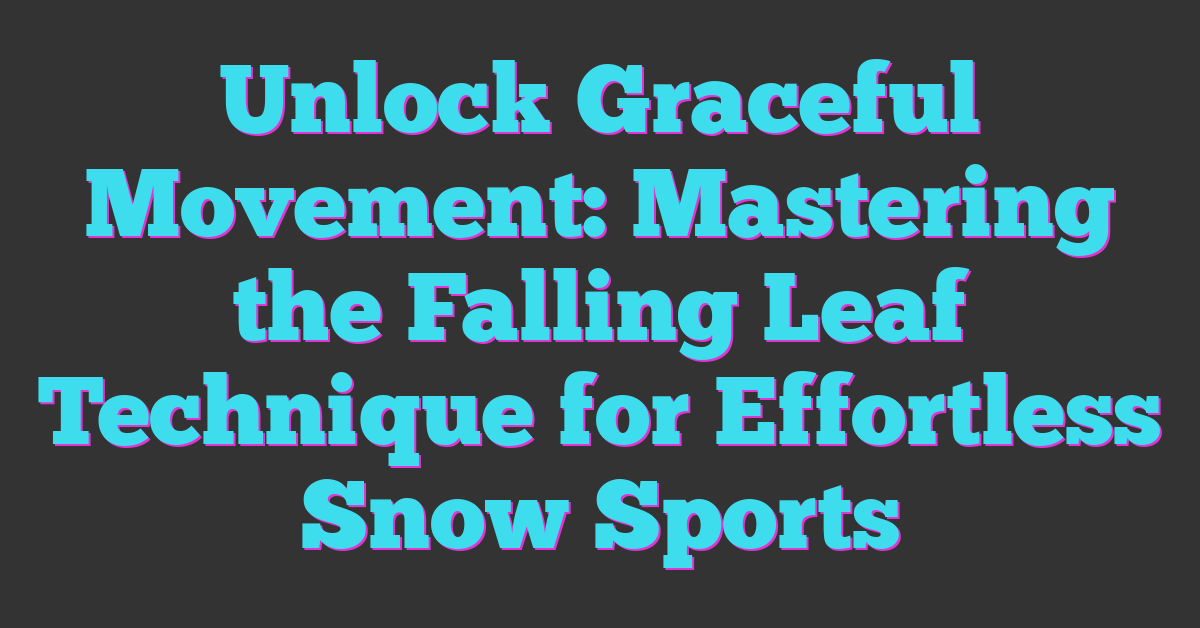Have you ever watched a leaf drift gracefully to the ground? The Falling Leaf Technique captures that effortless beauty in your movements, whether you’re dancing, practicing martial arts, or even doing yoga. This technique isn’t just about aesthetics; it’s about mastering control, balance, and fluidity in your practice.

Understanding the Falling Leaf Technique
The Falling Leaf Technique captures the essence of graceful movement, much like the serene descent of a leaf in autumn. This technique finds its place in various practices, enhancing your experience in snow sports through improved control and fluidity.
Origins and Background
The Falling Leaf Technique traces its origins to traditional arts and sports where motion mimics natural elements. In snow sports, it embodies the balance and flow of the body as you navigate the slopes. Many skiers and snowboarders adopted this technique to enhance their carving and turning skills. By harmonizing body movements with the forces of gravity and momentum, you can enjoy a more effortless ride down the mountain.
Key Principles and Concepts
Understanding the key principles of the Falling Leaf Technique helps enhance your snow sports experience. Focus on these concepts:
- Fluidity: Emphasize smooth transitions between turns to maintain momentum and efficiency.
- Control: Maintain a balanced posture, adjusting your center of gravity to adapt to terrain changes.
- Awareness: Stay attuned to your movements and the environment, responding to conditions in real-time.
- Connection: Foster a relationship between your body and the snow, ensuring every turn feels intentional.
- Relaxation: Keep your body relaxed, allowing for freer movements and reducing fatigue throughout your runs.
By mastering these principles, you can harness the Falling Leaf Technique to enhance your enjoyment and performance on the slopes.
Steps to Mastering the Falling Leaf Technique
Mastering the Falling Leaf Technique enhances your performance while enjoying the slopes. This technique allows for graceful movement, giving you a sense of freedom and control. Follow these steps to excel in this art.
Preparation and Mindset
- Visualize Your Journey: Picture yourself gliding effortlessly down the slope. Focus on the beauty of your movement, just like a leaf dancing in the wind.
- Embrace Relaxation: Approach the mountain with a calm mind. Stress and tension hinder fluidity. Relax your muscles to improve your control.
- Set Clear Intentions: Identify your goals before hitting the slopes. Whether it’s improving your turns, enhancing balance, or simply enjoying the ride, clear intentions guide your practice.
Execution Techniques
- Balance Your Weight: Shift your weight smoothly from one foot to the other. This shift mirrors the gentle sway of a leaf, allowing for seamless transitions.
- Engage Your Core: Activate your core muscles to maintain stability. A strong core aids in balance and control, keeping you centered during your descent.
- Use Your Arms: Extend your arms naturally as you turn. Let them flow alongside your movements, enhancing your overall grace and fluidity.
- Flow with the Terrain: Adjust your movements according to the slope. Anticipate changes and adapt quickly, mirroring the natural ebb and flow of a leaf in the breeze.
- Practice Mindfully: Focus on each movement rather than getting lost in speed. Practicing with intention builds muscle memory for smoother rides in the future.
By following these steps, you can master the Falling Leaf Technique, elevating your snow sports experience and allowing for a more enjoyable ride down the mountain.
Common Challenges and Solutions
Mastering the Falling Leaf Technique comes with its own set of challenges, but recognizing them leads to effective solutions. Here’s how to overcome common hurdles.
Overcoming Mental Blocks
Mental blocks can hinder your ability to fully embrace the Falling Leaf Technique. Fear of falling or making mistakes often creeps in, especially as you approach steeper slopes. To counter this, visualize your movements in a stress-free environment. Picture yourself gliding effortlessly down the mountain, allowing your mind to feel at ease. Use positive affirmations before your runs, reminding yourself of past successes and your capability to master this technique. Practicing mindfulness can also help you stay present, allowing you to focus on each movement rather than worrying about potential falls.
Physical Limitations
Physical limitations may pose significant barriers in executing the Falling Leaf Technique effectively. You might find core strength or balance challenging, which can affect your control and fluidity on the slopes. Strengthening your core through exercises like planks and rotations boosts stability while skiing or snowboarding. Engaging in flexibility training enhances your ability to move fluidly and respond to changing terrain. Incorporate targeted stretches into your routine, focusing on legs, hips, and back, to improve overall mobility. If persistent pain occurs, consult a physician or physical therapist for tailored advice.
Practice Strategies for Improvement
Improving your Falling Leaf Technique brings you closer to mastering graceful descents. Implementing specific drills and tracking your progress can enhance your skills and boost your confidence on the slopes.
Drills and Exercises
- Balance Drills: Use a balance board at home to mimic the movements while standing on your snowboard or skis. This enhances your core stability and balance.
- Core Strengthening: Incorporate exercises like planks and Russian twists into your routine. A strong core supports fluid movements, allowing you to shift weight effortlessly.
- Visualization: On your off-days, envision yourself flowing down the hill. Picture each turn and movement as if you’re floating like a leaf. This mental practice strengthens the connection between mind and body.
- Terrain Variability: Choose different slopes during practice. Varying conditions—like powder, groomed runs, or moguls—challenge your adaptability and encourage fluid transitions.
- Slow Motion Technique: Practice your movements in slow motion. This allows you to focus on weight distribution and balance while reinforcing proper technique without the speed pressure.
Tracking Progress
- Daily Journals: Keep a journal noting your experiences and techniques attempted during each session. This reflection helps identify areas of improvement and celebrates small victories.
- Video Analysis: Record your runs and review them. Watching your technique can highlight areas needing adjustment, showing your progress visually.
- Set Clear Goals: Define specific, measurable goals for your next outings. Whether it’s mastering a new slope or improving control, having concrete objectives keeps you motivated.
- Feedback Loop: Share your experiences with fellow snow sports enthusiasts or instructors. Constructive feedback can provide new insights and help refine your approach.
- Performance Checklists: Create a checklist of key techniques to focus on during each practice. Ensure you cover elements like weight distribution, body positioning, and fluidity. This structured approach keeps your practice sessions organized and effective.
Conclusion
Mastering the Falling Leaf Technique can truly transform your experience on the slopes. By embracing the principles of fluidity and control you’ll find yourself moving with grace and confidence. Remember to stay relaxed and keep your mind focused on the journey ahead.
As you practice and refine your skills don’t forget to celebrate your progress along the way. Each descent is an opportunity to connect with nature and enjoy the thrill of the ride. So gear up and let the beauty of this technique guide you down the mountain. Happy riding!










